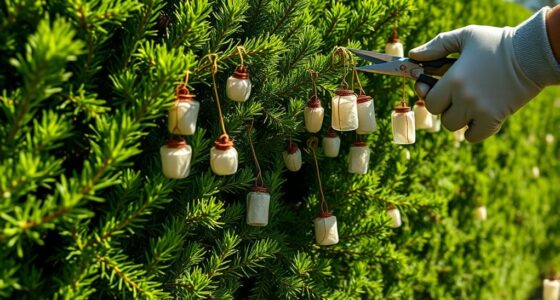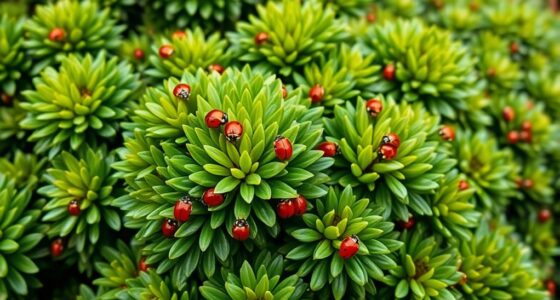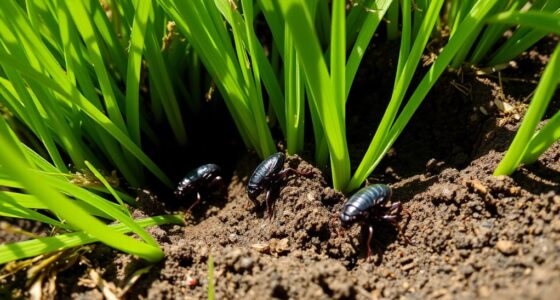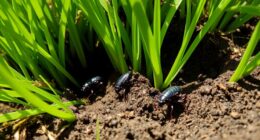If you notice patchy brown spots, ragged grass edges, or chewed leaves in your lawn, armyworms might be to blame. Look for worm activity during warm evenings or after heavy rain, and check for frass or insect activity. Act quickly with targeted pesticides and support natural predators like birds. Keeping your turf healthy through proper watering and mowing also helps prevent infestations. To learn more about protecting your lawn from armyworms, continue exploring effective control strategies.
Key Takeaways
- Look for patchy, ragged, or bare areas, chewed leaves, frass, and visible worms, especially after warm rains.
- Promptly apply targeted pesticides during early evening or morning when armyworms are active.
- Encourage natural predators like birds and parasitic wasps by maintaining a healthy, diverse yard ecosystem.
- Conduct regular lawn inspections and maintain proper watering, fertilizing, and mowing to strengthen turf defenses.
- Use an integrated approach combining chemical controls and natural predator support for effective, sustainable management.
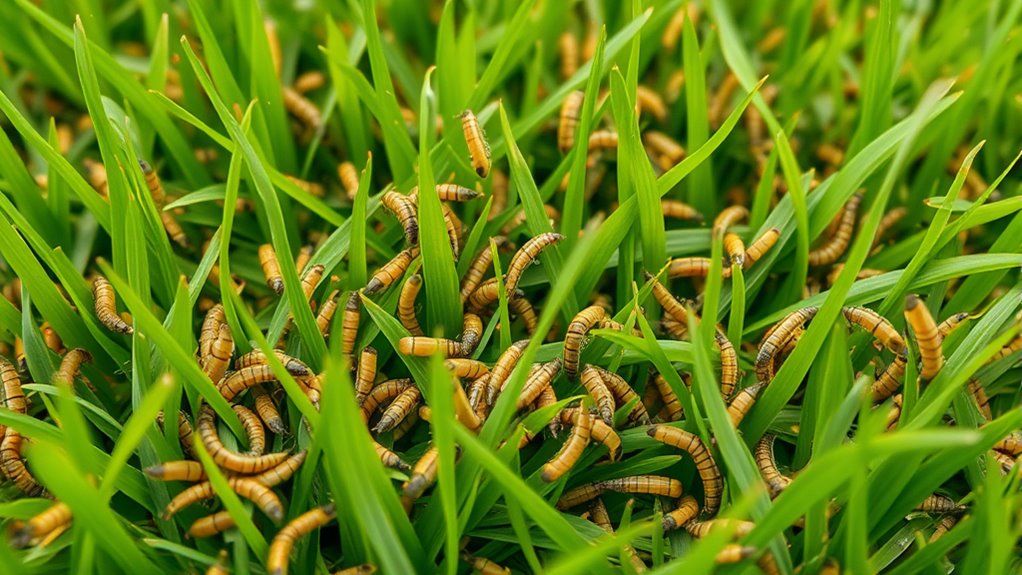
Armyworms can quickly become a serious problem for your turf, especially during warm, humid months. These voracious pests can cause extensive damage in a short amount of time, leaving your lawn riddled with bare patches and ragged grass. When you notice patchy areas or chewed leaves, it’s vital to act promptly to prevent further destruction. One of the most immediate responses is pesticide application, which can effectively control the infestation if used correctly. Choose a pesticide specifically formulated for armyworms and follow the label instructions carefully to guarantee safety and efficacy. Applying the pesticide in the early evening or early morning, when the worms are most active, can maximize the impact. Remember, a thorough coverage of the affected areas is essential for good results.
While chemical controls are often effective, you should also consider natural predators as part of an integrated pest management approach. Birds, certain beetles, and parasitic wasps naturally prey on armyworms and can help keep their populations in check. Encouraging these natural predators involves maintaining a healthy, diverse ecosystem in your yard. Avoid overusing broad-spectrum pesticides that can harm beneficial insects and disrupt the natural balance. Instead, foster habitats that attract these predators, such as leaving some leaf litter or providing birdhouses. This way, you create a natural line of defense that works alongside targeted pesticide application, reducing the need for repeated chemical treatments.
Monitoring your lawn regularly is key to catching armyworm problems early. Look for signs like chewed grass blades, frass (insect droppings), or the worms themselves, especially after warm rains or during late summer. When you spot the pests, act swiftly with a combination of targeted pesticide application and by supporting natural predators. This dual approach not only helps control the current infestation but also reduces the likelihood of future outbreaks. Keep in mind that healthy, well-maintained turf is less susceptible to severe damage; proper watering, fertilizing, and mowing practices strengthen your grass, making it more resistant to pest invasion. Additionally, maintaining optimal color accuracy in your turf’s appearance can help you better identify early signs of damage, as changes in color or texture become more noticeable.
Frequently Asked Questions
How Do I Differentiate Armyworms From Other Lawn Pests?
You can differentiate armyworms from other lawn pests by observing damage signs like irregular patches of brown or dead grass, often with chewed edges. Watch their feeding patterns — armyworms tend to feed in groups, moving quickly across the turf. They are active at night and hide during the day. Look for caterpillars with distinctive stripes or spots, which help confirm these pests compared to other insects.
Are Armyworms Harmful to Pets or Children?
Armyworms aren’t harmful to pets or children directly, but their presence can pose indirect risks. The larvae may cause skin irritation if touched, and the chemical treatments used to control them might affect pet safety and child safety. To keep everyone safe, avoid handling the worms and use pet- and child-friendly pest control methods. Always follow label instructions carefully, and consult a professional if you’re unsure about safe treatment options.
What Natural Predators Help Control Armyworm Populations?
Did you know beneficial insects can reduce armyworm populations by up to 80%? Natural controls like parasitic wasps, predatory beetles, and certain flies are your best allies. These beneficial insects hunt and feed on armyworms, helping keep infestations in check naturally. Encouraging their presence in your yard creates a sustainable, eco-friendly way to manage armyworms without chemical pesticides, protecting your turf and the environment.
Can Armyworms Re-Infest My Lawn After Treatment?
Yes, armyworms can re-infest your lawn after treatment. Chemical control methods may temporarily reduce their numbers, but if you don’t maintain proper lawn care, they can return. Regular lawn maintenance, like mowing and watering, helps keep your turf healthy and less attractive to armyworms. To prevent re-infestation, consider combining chemical control with good lawn practices, and monitor your yard regularly for early signs of these pests.
How Long Does It Typically Take to See Results After Treatment?
Like waiting for a telegram in the modern age, you’ll usually see treatment effectiveness within a few days to a week. Visible signs, such as green-up or improved grass health, indicate the treatment is working. Keep an eye out for continued damage or new armyworm activity, which could mean re-infestation. Consistent monitoring guarantees you catch any issues early and helps maintain a healthy, lush lawn.
Conclusion
Now that you know how to spot armyworms and manage them, aren’t your turf and lawn worth protecting? Staying vigilant and acting quickly can save your grass from lasting damage. Don’t let these pests take over—your healthy, lush lawn depends on your awareness and prompt action. Are you ready to take control and keep your yard beautiful all season long? Remember, a little effort now can prevent big problems later.


